Lactarius scrobiculatus (Scop.) Fr. - Spotted Milkcap
Phylum: Basidiomycota - Class: Agaricomycetes - Order: Russulales - Family: Russulaceae
Distribution - Taxonomic History - Etymology - Identification - Toxicity - Reference Sources
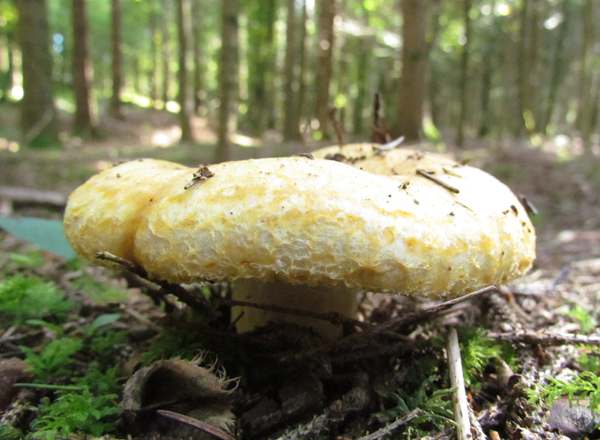
This beautiful, woolly-fringed mushroom is yet another of the many large milkcap species that are mycorrhizal with spruce trees. Unlike the very similar Yellow Bearded Milkcap Lactarius repraesentaneus, whose white latex (the milk-like liquid that oozes from cut or broken gills) turns lilac or purple as it dries, the latex from Lactarius scrobiculatus changes from white to sulphur yellow on exposure to air. There are other subtle differences, too - for example the spores are smaller than those of Lactarius repraesentaneus.
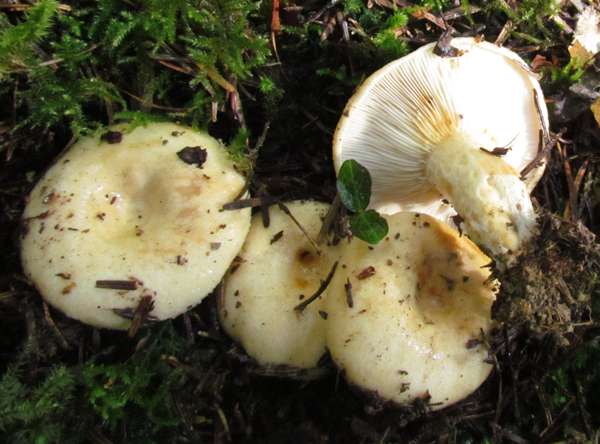
Distribution
This milkcap was last formally recorded in Britain and mostly seen in Scotland. Lactarius scrobiculatus occurs also on mainland Europe, and a very similar (but perhaps not co-specific) milkcap in North America is referred to as Lactarius scrobiculatus var. canadensis.
The pictures shown on this page was taken under a spruce tree in mixed woodland near Besancon, in central France.
Taxonomic history
This milkcap was first validly described in 1772 by Italian mycologist Giovanni Antonio Scopoli, who gave it the binomial scientific name Agaricus scrobiculatus. (In the early days of fungal taxonomy most gilled fungi were initially placed in a giant Agaricus genus, now largely redistributed across many other genera.)
It was the great Swedish mycologist Elias Magnus Fries who, in 1838, transferred this species to the genus Lactarius, thereby establishing its currently-accepted scientific name of Lactarius scrobiculatus.
Synonyms of Lactarius scrobiculatus include Agaricus scrobiculatus Scop., and Agaricus intermedius Fr.
Toxicity
Although it is unlikely to cause death or long-term illness, this is a poisonous mushroom and should definitely not be gathered for eating because it can cause unpleasant stomach pains, sickness and a burning sensation in the throat. It almost goes without saying that in some parts of Europe these fungi are eaten after frequent boiling and discarding the water in order to reduce the level of toxins.
Etymology
The generic name Lactarius means producing milk (lactating) - a reference to the milky latex that is exuded from the gills of milkcap fungi when they are cut or torn. The specific epithet scrobiculatus comes from Latin scrobis, meaning a trench. The diminutive form scrobiculus is a small trench or pit (a planting hole, for example), and scrobicules is the technical name for those oval pits on the stem surface of a subgroup of Lactarius known as the 'Scrobiculati'.
Identification guide
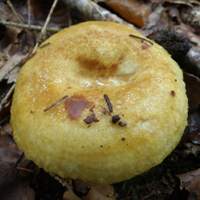 |
CapInitially convex, becoming centrally depressed or broadly funnel shaped but retaining a slightly inrolled margin, which is overhung by woolly strands; 5 to 15cm in diameter. Cap surface is yellow or yellow-orange, with indistinct concentric rings of small scales appearing as dark-and-light colour zones; slimy, especially in wet weather. Bruised areas turn a dirty brown colour. The cap flesh is white and turns yellow on exposure to air. |
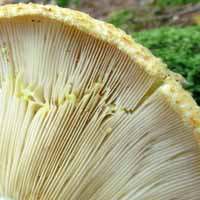 |
GillsThe adnate or shortly decurrent, crowded whitish gills eventually turn yellow or pale orange; when damaged they become stained by a copious creamy white latex that quickly turns sulphur yellow. |
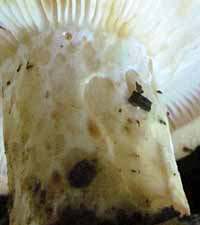 |
Stem3 to 6 cm long and 1.3 to 3.5cm in diameter; cylindrical or slightly clavate; slimy when fresh. The stem surface pale yellow with an extensive random covering of slightly darker oval hollows (known as scrobicules). The stem base is downy. As with other members of the family Russulaceae, there is no stem ring. |
SporesBroadly ellipsoidal, 9-11 x 7.5-9µm; ornamented with low (<0.8µm) warts joined by ridges that do not form a complete reticulum. Spore printCream. |
|
Odour/taste |
Faintly fruity odour; taste very hot and acrid. |
Habitat & Ecological role |
Mycorrhizal, often in small groups, with spruce trees. |
Season |
August to November in central Europe. |
Similar species |
Lactarius repraesentaneus produces latex that turn lilac; its spores are larger. Lactarius torminosus has a pale pink to pinkish-orange woolly cap and grows under birches usually in damp soil. Lactarius pubescens has a buff-white or cream woolly cap and grows mainly in damp grass under birch trees. |
Reference Sources
Fascinated by Fungi, 2nd Edition, Pat O'Reilly 2016, reprinted by Coch-y-bonddu Books in 2022.
Funga Nordica, Henning Knudsen and Jan Vesterholt, 2008.
Fungi of Switzerland, volume 6: Russulaceae, Kränzlin, F.
BMS List of English Names for Fungi.
Dictionary of the Fungi; Paul M. Kirk, Paul F. Cannon, David W. Minter and J. A. Stalpers; CABI, 2008
Taxonomic history and synonym information on these pages is drawn from many sources but in particular from the British Mycological Society's GB Checklist of Fungi.
Fascinated by Fungi. Back by popular demand, Pat O'Reilly's best-selling 450-page hardback book is available now. The latest second edition was republished with a sparkling new cover design in September 2022 by Coch-y-Bonddu Books. Full details and copies are available from the publisher's online bookshop...

